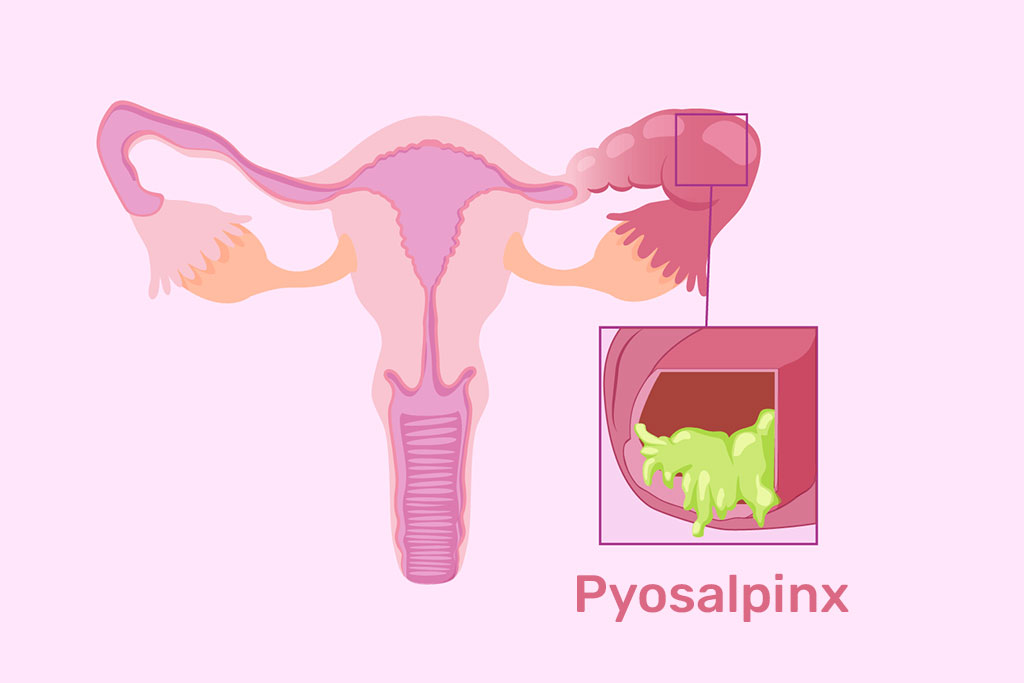What Are the Causes of Pyosalpinx?
As we mentioned, pyosalpinx is a complication of the body’s immune response to an infection or a direct result of an infection. Several reasons cause Pyosalpinx.
Here’s a breakdown of the main causes of pyosalpinx.
- Pelvic Inflammatory Disease (PID): This is the leading cause of pyosalpinx. PID is an infection of the female reproductive organs, often caused by sexually transmitted infections (STIs) like chlamydia and gonorrhoea. These bacteria ascend from the cervix and uterus, reaching the fallopian tubes and causing inflammation. If left untreated, PID can lead to tubal blockage and pus accumulation, resulting in pyosalpinx.
- Other Bacterial Infections: Though less common, bacteria from the vagina or cervix, not necessarily STI-related, can also ascend and infect the fallopian tubes. This can occur after childbirth, miscarriage, or certain gynaecological procedures.
- Transmitted infections and infections after abortion or childbirth can also cause pyosalpinx.
- In some cases, pyosalpinx may arise as a complication following surgery, particularly if the surgical site becomes contaminated.
What Are the Symptoms of Pyosalpinx
The following are the symptoms that accompany pyosalpinx.
Lower Abdominal Pain: This is the most frequent symptom and can range from dull and achy to sharp and stabbing. The pain is typically felt in the lower abdomen on one or both sides. It may worsen during movement, sexual intercourse, or bowel movements.
Fever and Chills: Due to the presence of infection, a fever is a common symptom, often accompanied by chills.
Nausea and Vomiting: Pelvic inflammation can irritate the gastrointestinal system, leading to nausea and vomiting.
Abnormal Vaginal Discharge: The discharge may be thick, pus-like, yellow or greenish, and may have a foul odour due to the infection.
Pain During Intercourse (Dyspareunia): Inflammation and tenderness in the pelvic area can make intercourse painful.
Irregular Menstrual Bleeding: Hormonal imbalances caused by the infection can disrupt the menstrual cycle, leading to irregular bleeding, heavier periods, or spotting between periods.
Pelvic Mass: A swollen and pus-filled fallopian tube can sometimes be felt as a mass during a pelvic exam.
Other Symptoms:
- Pain radiating to the lower back or thighs
- Difficulty in conceiving
- Feeling faint or dizzy
It is important to note that not all women experience all the symptoms listed above. Some may have only a few mild symptoms or even none at all.
What Are the Treatments of Pyosalpinx
Pyosalpinx treatment depends on the severity of the infection and your desire for future fertility. Here’s a breakdown of the treatment options:
Antibiotics: This is the first line of treatment, especially for mild cases of pyosalpinx. A combination of broad-spectrum antibiotics will be administered intravenously (through a vein) initially, followed by oral antibiotics to complete the course.
Surgical Procedures: If antibiotics fail to control the infection or the condition is severe, surgery might be necessary. There are several surgical approaches, such as Laparoscopic Salpingectomy, Laparoscopic Salpingostomy, Laparoscopic Aspiration and Drainage, and Laparotomy.
Pain Management: Medications like pain relievers and anti-inflammatory drugs can help manage pain associated with pyosalpinx.
The following factors are considered when recommending the best treatment approach.
- The severity of the infection
- Your desire for future pregnancy
- Your overall health condition
- Previous surgeries in the pelvic area
It’s crucial to discuss all pyosalpinx treatment options with your doctor to understand the benefits, risks, and potential outcomes of each procedure. Early diagnosis and prompt treatment are essential for a successful recovery and minimising complications.
Conclusion
In conclusion, pyosalpinx is a serious condition that can lead to infertility and sepsis if not treated promptly. Early detection and immediate treatment with antibiotics, pus drainage, and, in severe cases, surgery are crucial to prevent complications and safeguard fertility. It is essential to seek medical attention as soon as possible if you experience any symptoms of pyosalpinx to prevent the condition from worsening. Remember, prevention is always better than cure, so prioritise your reproductive health and seek medical care if you suspect any issues.

